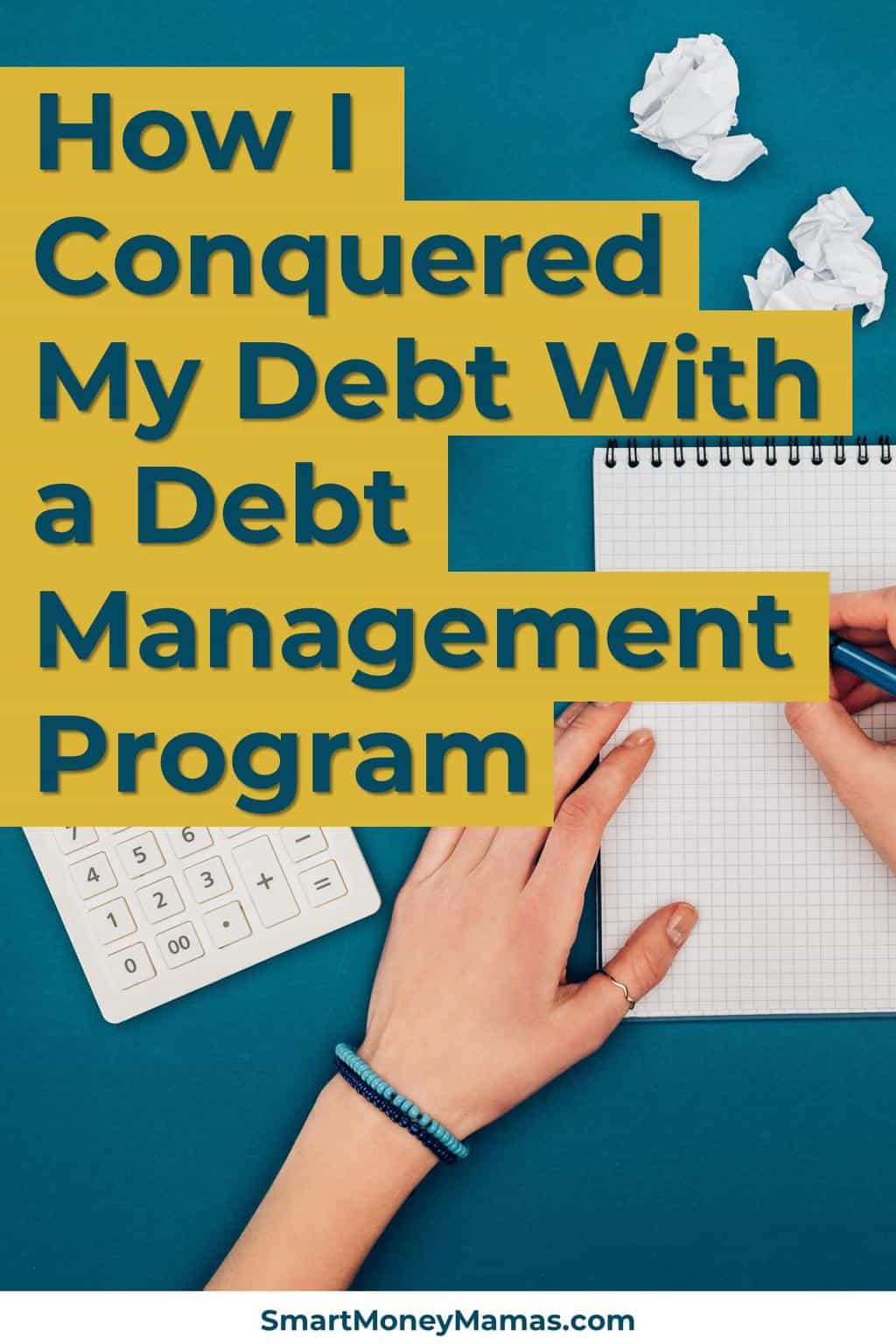Are you struggling to find relief from your debt and unable to make payments each month? Have you already tried cutting your budget and still just feel stuck? Then, a Debt Management Program (DMP) might be a good option for you.
Whoa! Wait! I know what you’re thinking. “Debt Management Programs are scams that cost tons of money and don’t get you out of debt.” And I had the same reaction when I first considered this route.
But there’s a lot of misinformation in this space and terms get used interchangeably. Under a debt management program, you pay a single company each month instead of paying all your different creditors individually. Typically, the debt management company will negotiate to lower your interest rates and payments with your creditors. It can be extremely helpful when you’re struggling.
Today, I want to clear up some of the confusion, share my experience with a DMP, and what you should consider before signing up for a debt management program.
Table of Contents
What Led Me to a Debt Management Program

The final straw was the $4,000 veterinary bill.
Actually, this was the second $4,000 vet bill in 4 years. It was awful both times. And we were forced to make fast decisions under very emotional circumstances. We used CareCredit to pay the big bills.
Our CareCredit balance was added to $28,000 in credit card debt.
You see, my husband and I were spenders. If we wanted something, we bought it. There was no saving up over time, even over two to three paychecks. Spending slowed as balances got higher, but by then the damage had been done.
We’d tried to pay it down ourselves. Usually, we even paid more than the minimum. But we weren’t making any headway. I didn’t have the tools to handle this problem better than we were. I just knew I was tired of spinning my wheels.
Then, I found out that my coworker and her husband paid off over $95,000 in credit card debt in 4 years through Money Management International (MMI), a nonprofit company that helps people handle their money problems. She told me it changed her life. Her husband had a worse spending problem than we did and there was no way she could tackle their debt without help.
I’d heard horrible things about managing debt through a third party. That it was expensive and didn’t help you solve the real problem. But I was at my wit’s end. I started looking into it.
Debt Consolidation vs. Debt Relief
People generally don’t understand the distinction between debt consolidation, debt management, and debt relief. I certainly didn’t when I started.
With a Debt Consolidation Loan, you get a loan through a lender, like LendingClub or bank. You use it to pay off your creditors, and then pay the new loan off over time. You will still pay the full amount you owe, but hopefully at a lower rate than you already have.
Tackling your debt this way will affect your credit score like any other loan: your score will go down at first, but if you make payments on time your score will slowly increase.
One downside of debt consolidation loans is that you can still use credit cards and other forms of credit. So, if you don’t fix the habits that got you into heavy debt in the first place, you could end up making the problems worse by adding new credit card debt.
However, if you have addressed your spending problems and can negotiate with your existing lenders, this can be a cheaper option than a debt management program.
A Debt Management Program is still debt consolidation but without a new loan. Instead, you work with a credit counseling agency to lower the interest rates and fees of your credit cards. Then, you pay the agency each month and they distribute payments to your creditors.
You may have to close the credit cards and agree not to open anymore. But you get free credit and money counseling, and your credit score and report are rarely affected.
A downside is that you will probably pay a monthly fee.
Finally, with Debt Relief, you pay part of your debt but get the rest forgiven. Debt settlement and filing for bankruptcy are forms of debt relief. This reflects negatively on your credit score and report for years and should be a last resort.
Making The Jump

After talking with my coworker more and researching the company (MMI has an A+ BBB rating), I talked to my husband. He agreed we needed to do something about our debt but he was wary. Just like me, he had misconceptions about how it would work. We decided to get more information before making a decision.
I got paperwork together and one Sunday afternoon I called MMI. I spoke with a man who, to be honest, sounded like a used car salesman. The process was long and even though I thought I was prepared, I really wasn’t. It was overwhelming.
They needed to know how much money we made and where it all went.

I had no idea how much we spent on food, gas, personal care, or any of the other categories. We didn’t track it. I had some ballpark numbers off the top of my head (food, entertainment) and some firm numbers (mortgage, car loans). So, I did the best I could.
It was enough.
He plugged everything into their system, put me on hold and talked to Chase and CareCredit to negotiate our interest rates down. It didn’t take long. Quickly, MMI had our proposed plan:
- We would pay MMI $715 per month over 4 years. This was more than the combined minimums we’d been paying.
- The two Chase cards would drop their rates to 3.5% and CareCredit would drop to 15%.
- A single late payment would void the program.
- There was a $40 fee built into the monthly payment.
- We couldn’t open any more credit cards until the plan was paid off.
I talked it over with my husband. He wasn’t happy about not being able to use credit. But I liked that restriction. I mean, why have the temptation?
In the end, we accepted the terms and signed up. We felt the benefits outweighed the negatives.
Ultimately, using the plan helped us pay off our debt in three-and-a-half years. Yet, with a monthly payment that was almost as much as our mortgage, we had some difficult months along the way. But it was worth it to get out of debt.
Our Experience With a Debt Management Program

There were many benefits to signing up for a debt management program:
- MMI reduced our interest rates so more money went to paying principle. This was the top benefit to us.
- A single automated payment was convenient.
- We received free credit and money counseling.
- We paid our debt in less than four years.
But there were also some negatives:
- We couldn’t use the credit cards enrolled in the program. But was this really a negative?
- The CareCredit card in my husband’s name viewed the DMP negatively and it negatively impacted his credit.
- We had one large lump payment each month.
- We paid a monthly fee.
If we’d been more responsible we could have easily worked out a plan like this ourselves. We could have negotiated interest rates down, stopped spending on credit, and made larger monthly payments. And not had that $40 per month fee.
But would we have done that? Probably not. We just didn’t have the knowledge or money management skills.
Avoiding Debt Management Program Scams
- Look for non-profit institutions and accreditations. Good debt management programs will have accreditations from trustworthy organizations like the National Foundation for Credit Counseling (NFCC), Council on Accreditation (COA), and the Better Business Bureau (BBB).
- You should initiate contact. Companies that reach out to you without you having asked for help is a major red flag.
- Pricing should be reasonable. Initial costs should be $75 or less with a monthly fee of no more than $50 a month. (This can be lowered at many companies based on your ability to pay.
- Don’t trust guarantees. No DMP can guarantee lower payments or interest rates before they negotiate with your lenders.
Final Thoughts
If your family has debt and doesn’t know where to begin, calling a nonprofit debt management company or credit counselor like MMI is a good first step.
The credit counselors provide options to help you sort things out and give you tools to use even if you decide not to enroll. (Any reputable debt management program should make you start by speaking with a credit counselor.) Most agencies offer free resources on topics like avoiding foreclosure, repaying student loans and budgeting. And free is the best price, right?
If you do enroll, a debt management program can teach you how to be more strict with your money and your family will learn to budget better. But it is restrictive, taking on average three to five years to complete and limiting your access to credit.
So, if you have more self-discipline than we did, you can create your own debt management program and skip the fee so more of your money will go to principle. This may be the best option for families where everyone is on board with making changes to financial habits.
For us, a debt management program changed our financial lives. If you’re feeling stuck and overwhelmed, it could be worth a call.
Have you ever considered a debt management program? What was your experience or what held you back? Share in the comments!




I have always heard horror stories about debt consolidation and debt relief programs. We worked tirelessly for about 3 years paying down our debts using the debt snowball until we finally took the leap and consolidated our remaining debts into one loan. The minimum payment is about the same as the individual cards, but the interest rate is much lower, and we know everything will be paid off by a certain date. It was honestly such relief to us to take out the consolidation loan and have a plan in place. I am glad that the debt management company worked for your family!
That’s exactly how I felt! It was tough for us because our payments to MMI were almost as much as our monthly mortgage payment, but it was a relief to know we were taking action. Seeing the balances drop so quickly kept us going. I’m really glad you found a path that works for you!
Informative article. Sadly, this will be my 2nd time around with MMI. Ive told a few close friends and I can see the judgement and worry in their faces.
Everyone has their own situation. Part of my DMP is going to be a CareCredit card also. Have you found the credit score bounced back eventually from negative impact?
MMI said the rates in the form I signed were pre-negotiated. Did you experience anything where they told you what the cost would be and then your rate and what was accepted changed, early on??